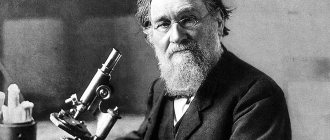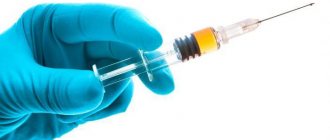How was the polio vaccine created? Why, at the height of the Cold War, did the USSR and the USA have to become allies in the fight against this disease?
The polio virus is insidious. In the vast majority of cases, it causes only mild discomfort. But in two cases out of a hundred, paralysis, lifelong lameness occurs, and in the worst case, painful death. That is, if the immune system is strong, the infection will quickly capitulate. If not, it penetrates the blood and reaches the nerve cells of the brain and spinal cord. If 25% of the spinal cord neurons are killed, then the patient develops paresis - partial loss of motor function. If 75% is already paralysis. After the death of neurons, the muscles of the limbs (usually the legs) atrophy. Because of this, bones do not grow, and joints stretch unevenly and bend.
The infectious nature of polio was discovered by the Swedish pediatrician Karl Oscar Medin in 1980, and 19 years later, doctors Karl Landsteiner and Erwin Popper proved that the causative agent of polio is a virus from the picornavirus family.
WHO warns of a possible outbreak of measles and polio Read more
Crippling Virus
The infection enters the body through the mouth. If the immune system is strong, the infection quickly capitulates. If not, it penetrates the blood and reaches the nerve cells of the brain and spinal cord. 25% of spinal cord neurons are killed - and the patient develops paresis - partial loss of motor function. 75% is already paralysis. After the death of neurons, the muscles of the limbs (usually the legs) atrophy. Because of this, bones do not grow, and joints stretch unevenly and bend.
Electron micrograph of polio virus. Photo: Public Domain
In 1890, Swedish pediatrician Karl Oskar Medin discovered the infectious nature of polio, but could not find the culprit of the infection. 19 years later, Karl Landsteiner and Erwin Popper . They proved that the causative agent of polio is a virus from the picornavirus family.
Historical aspect.
Also on topic:
NERVOUS SYSTEM
Polio was probably known already in antiquity: in some ancient Egyptian images one can see cripples resembling polio patients. The first detailed description of the disease was made in 1784 by M. Underwood. In 1840, J. Heine found out that the disease is characterized by the destruction of motor nerve cells in the spinal cord. In 1890, K. Medin drew attention to the epidemic spread of the disease. In 1909, K. Landsteiner and G. Popper managed to infect monkeys with polio by instilling bacteria-free filtrate of mucus from the throat of a sick person into their noses. Thus, it was proven that the disease is caused by a filterable virus. Several severe epidemics in the United States in 1916 and subsequent years gave impetus to intensive research conducted by American scientists. It has been established that the polio virus is one of the smallest; its diameter is 30 millimicrons. Three main immunological types of the virus were isolated, and in 1950 J. Enders managed to grow them in tissue culture. In 1955 they were obtained in concentrated form, purified and crystallized in W. Stanley's laboratory.
Enemies and allies
Summer 1921. In the USA there is a disaster on a national scale. In the east of the country, two thousand people, most of them children, die from a polio outbreak within three months. Seven thousand patients remain paralyzed. The peak of the epidemic in the United States was 1952. 58 thousand sick! 10% of them, mostly children, died from complications - pneumonia and paralysis of the respiratory muscles.
In the USSR, the polio epidemic began 30 years later. The problem of disease prevention was quickly elevated to the rank of the most important government tasks. In Moscow, the work on creating a vaccine was led by Mikhail Chumakov , director of the new polio institute. In Leningrad, the Department of Virology of the Institute of Experimental Medicine, headed by Academician Anatoly Smorodintsev, . But Soviet scientists received help from where they did not expect - from the USA. In 1953, American virologist Jonas Salk introduced the world to the first “killed”, that is, inactivated, vaccine. It was based on poliovirus grown in the kidney tissue of African monkeys and chemically “turned off” with formaldehyde.
Vaccine against fear. How the USSR and the USA defeated polio together Read more
Mass vaccination in America began in April '54. And it ended in a huge scandal. Hundreds of vaccinated children became infected with polio. The US Public Health Service investigated and found that some batches of vaccines contained live rather than neutralized virus. Obviously, the manufacturers violated the technology. At this moment, another American virologist, Albert Sabin , risked introducing a new type of polyvaccine - live! He was convinced that a live oral vaccine would produce more reliable immunity. But there was no chance of testing, much less vaccination, in the United States after the scandal with the “killed” vaccine. And then Albert Sabin makes a historic decision. At the height of the Cold War, the scientist transferred all his work to his Soviet colleagues - M. Chumakov and A. Smorodintsev. Science turned out to be higher than politics. Work was in full swing at the Leningrad Institute of Experimental Medicine and the Moscow Research Institute of Poliomyelitis. In the fall of 1956, the first tests began.
Photo: Flickr.com
Tested on my granddaughter
While testing a new vaccine, scientists from the Department of Virology at the Leningrad Institute of Experimental Medicine take a risk: they drink a glass of water in which a “tamed” strain of the disease is diluted. The risky experiment is successful, but for the final stage of testing, not an adult is needed, but a child - healthy and not immune to a dangerous disease.
It was impossible to find parents who would voluntarily agree to vaccinate their child with a live experimental vaccine. And then Academician Anatoly Smorodintsev brings the finished drug to his home. At dinner, he drips it onto cookies and treats his six-year-old granddaughter Lena to them... The tense days of waiting begin. Every day the girl is examined by several doctors: they measure her temperature, check her reflexes, conduct tests... After two weeks, antibodies appear in Lena’s blood! She's protected! This day becomes a holiday for Lena’s grandfather, all his colleagues and, of course, the “father” of the live vaccine - Albert Seibin. By 1963, instead of tens of thousands of cases, only a few hundred cases of infection were registered in the USSR. The epidemic is on the decline. Since the mid-60s, the Soviet live vaccine has been exported.
Institute of Poliomyelitis and Viral Encephalitis of the USSR Academy of Medical Sciences (now named after M.P. Chumakov RAS). Production of polio vaccine under completely sterile conditions. 1963 Photo: RIA Novosti/ Lev Ustinov
Vaccination in a new way
Half a century later, the World Health Organization nevertheless took steps to switch from a live vaccine to a “killed” vaccine. There are a number of reasons for this. Firstly, there has been no mass morbidity for a long time. Secondly, the live virus, although weakened, can be released into the environment for another two months and infect unvaccinated people. As a result, the virus mutates, new strains emerge that can cause dangerous disease. The first Russian inactivated polio vaccine is produced by a biotechnological complex in the Kirov region. It is a suspension of “killed” polio viruses and is effective against three types of pathogen at once. It can be combined with any vaccinations of the National Calendar, with the exception of anti-tuberculosis and BCG. Since the drug does not contain a live virus, it can be vaccinated against weakened children, pregnant and lactating women, and even patients with immunodeficiency.

Life-saving vaccine. How are vaccines developed today? More details
There are contraindications. Be sure to consult your doctor.
Is polio coming back?
Someone said that when a disease leaves, it looks back: is it possible to return?
1980 was the year of the official declaration of the eradication of smallpox, one of the most dangerous infectious diseases known to science in human history. For decades now, there has been a struggle to obtain the same status for another disease.
Polio. Today we are talking about him.
For reference. Poliomyelitis: what is this disease and how is it transmitted?
This is an infectious disease caused by poliovirus. The pathogen enters the body through water or food contaminated with fecal particles from an infected person. Multiplying in the intestines, it penetrates the blood and spreads throughout the body. Among the cells attacked by the virus are neurons of various parts of the central nervous system: the brain stem, cerebellum, and cerebral cortex. Its most preferred target is the so-called horns of the spinal cord: the neurons located here provide the movement of skeletal muscles.
The virus is also released into the environment through the intestines and can be transmitted further to other people.
In the language of numbers. Does polio still exist in Russia and the world?
According to open source data, cases of polio are periodically recorded in many countries around the world, including in our country. So, in 2015, after many years of “calm”, a single case of this disease was registered. Later, 4 more carriers of the virus were discovered.
As of the end of 2021, there is a risk of contracting polio due to a shortage of vaccine preparations.
Since the creation of the Global Polio Eradication Initiative (GPEI) in 1988, global polio incidence statistics have changed dramatically, as evidenced by an almost 100% decline in the number of cases.
Doesn't spare anyone. Which famous people suffered from polio?
Illness is the great equalizer. According to historical information, Franklin Roosevelt, the 32nd President of the United States, suffered from this illness. One day he simply swam in one of the many Canadian lakes. Roosevelt's symptoms of the disease were misinterpreted, which led to erroneous treatment tactics and the subsequent development of paralysis. Later, the correct diagnosis was made, but, unfortunately, the therapy did not lead to the restoration of leg function.
Frida Kahlo is a famous Mexican artist who suffered from this terrible disease at the age of six. Doctors managed to save the girl, but one of her legs became thinner and shorter than the other, which caused the development of lameness. Even as a child, the future artist fully realized what it meant to struggle, including with her illness. She played football with the boys, did boxing and swimming. Alas, polio was not the only serious test for body and spirit in her life...
In the name of salvation. How was the polio vaccine created?
The history of vaccination against this disease has been difficult. Shortly before the end of the 40s of the last century, a doctor from the University of Pittsburgh, Jonas Salk, headed the virology laboratory. In 1952, he brought together several types of polioviruses obtained from monkey kidney cultures. The viruses were treated with formaldehyde, after which they were unable to cause the development of the disease, but when introduced into the body, an immune response was developed to them. At the same time, he begins the first human trials of the vaccine and publishes the data obtained.
Perhaps the reader has a question: is it possible to get polio after vaccination? After all, it contains, although “killed,” viruses, they are still viruses? In the spring of 1954, the first vaccination campaign with Salka began, school-age children were vaccinated. Unfortunately, tragedy struck: several hundred of those immunized developed the disease, and deaths were also reported. Presumably, the vaccine viruses were not completely inactivated, which led to such consequences.
The vaccine was improved, and already in 1955, more than 4 million doses were used in the United States. Four years later it was already used in many countries around the world.
In 1957, another American researcher, Albert Sabin, reports a live oral vaccine. The microbiologist believed that the inactivated Salk vaccine was not able to prevent the development of epidemics. According to Sabin, his live vaccine was supposed to essentially reproduce the disease. For this purpose it was supposed to use a weakened form of the pathogen. As a result of numerous experiments, a rare type of pathogen was obtained that reproduces in the digestive system and does not attack the nervous system. A year later, the drug is tested in the United States, and a few years later the “sugar cube vaccine” becomes publicly available.
In the Soviet Union, Mikhail Chumakov, Anatoly Smorodintsev and others were involved in the development of the vaccine, its release and mass use. It was here that polio as a mass disease was eradicated for the first time in the world. Drug Research Institute named after. Chumakov was widely used in Japan and all socialist countries.
Be alert. Symptoms of polio in children and adults
Mostly children suffer from it. In adults, the disease is more severe. Manifestations of the disease are varied and include, in particular, increased body temperature, fatigue, vomiting, upset stool, sweating, variability in blood pressure, headache, tension in the occipital region, muscle pain, paresis and paralysis.
Can polio be cured?
Often the disease ends with complete recovery. Muscle strength begins to recover after a few days, increasing over the next 1-2 years. Some patients may have residual paralysis, which is permanent in 1 in 200 patients (usually in the legs). Between 5 and 10% of paralyzed patients die from paralysis of the respiratory muscles.
There is currently no specific antiviral drug for the developed disease.
Prevent and neutralize. At what age do children get the polio vaccine?
Typically, a child is vaccinated at three, four and a half, six, eighteen, twenty months, and then at 14 years.
A consultation with a pediatrician is required to assess the child’s condition, including his immune system, and to determine the type of vaccine that will be used. In particular, children with impaired immunity have their own vaccination characteristics.
Globally and on a large scale. How will the World Health Organization help eradicate polio?
Today, polio outbreaks are still possible. Activities to stop this disease include: improving routine immunization; improving epidemiological surveillance in high-risk areas; raising people's awareness; development of special events to reach migrant children, in conflict zones, remote areas, mobile population groups and some others.










